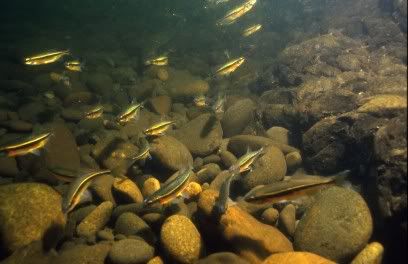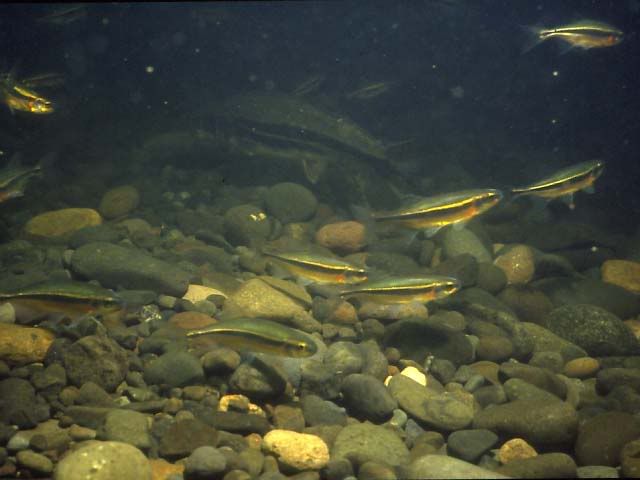I have been following the redside shiner (Richardsonius balteatus [Richardson]) since the 1980s, first in the North Umpqua River in Douglas County, Oregon and now in the Clackamas River near Portland, Oregon (actually in Gladstone, Oregon). Each year, I would wait for them to congregate in schools, in the deeper holes of the river, and watch as the river temperature got higher and they gained their spectacular red side prior to mating. They would come together in schools of 20-50 fish, and the males would follow a female as she dived into the larger rocks to spawn on their underside. The males would be right behind her (up-current) and deliver the sperm as she laid her eggs on the underside of these rocks.


Redside shiners spawning in the North Umpqua River
Well, this year everything looked good with a large flow of springtime water down the Clackamas River, and the gathering of the redside shiners. They schooled in a group of at least 100 individuals, and there were salmon smolt mixed in. The salmon smolt seem to use these schools for shelter from other predators, including the Northern Pike Minnow and small mouth bass (an introduced and non-native fish). But this year, we seemed not to have summer, and the river never heated to above 60 degrees F. This is the temperature that I have observed is necessary for the redside shiners to change color and begin mating. It probably has to do with the survival of the eggs, although I am not sure why their mating is so temperature-dependent. Because of that, this year for the first time since I've been observing them, the redside shiners failed to spawn.
I don't know if there is any significance to this, but thought I'd post it anyway to see what you might think.
SeaRat


Redside shiners spawning in the North Umpqua River
Well, this year everything looked good with a large flow of springtime water down the Clackamas River, and the gathering of the redside shiners. They schooled in a group of at least 100 individuals, and there were salmon smolt mixed in. The salmon smolt seem to use these schools for shelter from other predators, including the Northern Pike Minnow and small mouth bass (an introduced and non-native fish). But this year, we seemed not to have summer, and the river never heated to above 60 degrees F. This is the temperature that I have observed is necessary for the redside shiners to change color and begin mating. It probably has to do with the survival of the eggs, although I am not sure why their mating is so temperature-dependent. Because of that, this year for the first time since I've been observing them, the redside shiners failed to spawn.
I don't know if there is any significance to this, but thought I'd post it anyway to see what you might think.
SeaRat




